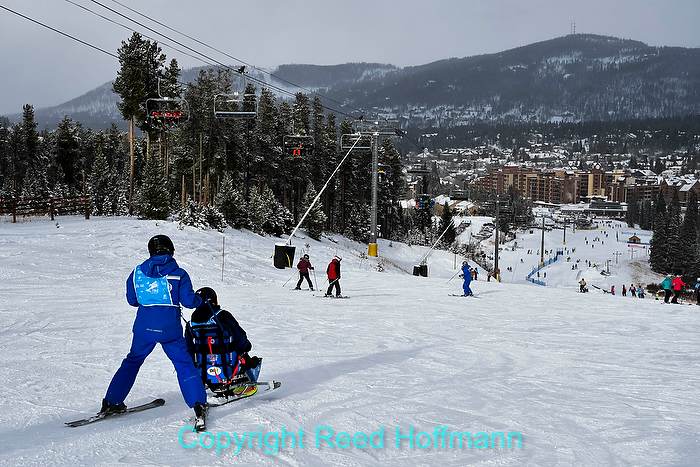One of the biggest challenges facing photographers is finding new and different ways to make pictures. That’s especially true when shooting something you’ve shot before. Which means it’s time to think through your options.
For the last eight years I’ve spent the beginning of December in Colorado doing photography for Disabled Sports USA. They run a learn-to-ski program and race camp in Breckenridge called “The Hartford Ski Spectacular,” which brings in hundreds of participants and volunteers from around the country. I help out by creating still images and video packages they’ll use the rest of the year to promote that event as well as other programs. It’s a great bunch of people, from the staff to the volunteers to the participants, and I look forward to it each year. After all these years, though, my biggest challenge is finding new images to make, or new ways to make those images. What follows is a sampling of some of that from this December.
Snowboarding was added to the Paralympics a few years ago, and that’s meant an increased emphasis on the sport. This year the gate panels on the course have the DSUSA logo, so making photos with that in them was a priority. I could always shoot with a telephoto from the side of the course, but wanted something more dynamic, which meant closer. To do that, I brought a super-wide lens out on the mountain, and also a couple of strobes. That was the “think different” part of the plan. I wanted to use off-camera flash to create something a little special.
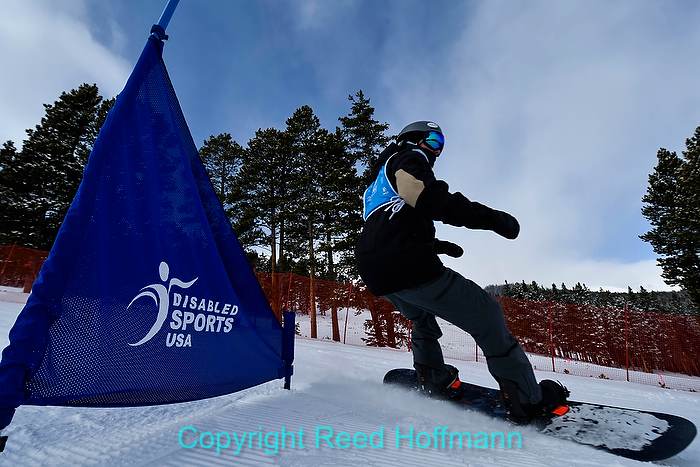
The low angle and super-wide lens make this picture work, but the overcast sky, with resulting soft light, is lacking in contrast. Nikon D500, Manual mode, ISO 200, 1/1250 at f/5.6, EV +0.3, 10-24mm f/4 Nikkor lens at 10mm. Photo copyright Reed Hoffmann.
Direct flash, with the light coming from the camera, is flat and boring. So whenever possible, you should try to get it off-camera. I shoot Nikon cameras, and they have something called “Commander Mode,” that lets me trigger most Nikon flashes without being connected to the camera. Except for the newest model (the SB-5000, which has radio control), this is accomplished optically, with an infrared signal. Outdoors, in bright light, it can be challenging to get that signal to trigger the flash, especially if that flash is far away or well off to the side. That’s why instead of using the SU-800 module (which mounts on the hotshoe and faces forward), I used the little SB-500 flash as the trigger. It can be set to operate as the “Commander,” and the head swivels, so I could point it at the “Remote” flash (an older SB-800). That took care of making sure the camera could communicate with the flash, but there was another issue – light.
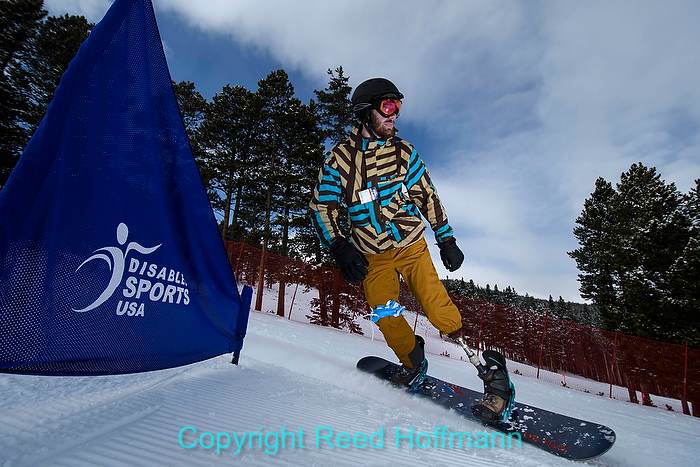
Using the flash, coming in from the right side, gives the picture more “pop,” adding to the nice angle and framing. Nikon D500, Manual mode, ISO 320, 1/2000 at f/5.6, EV +0.7, 10-24mm f/4 Nikkor lens at 10mm. Photo copyright Reed Hoffmann.
Using flash outdoors in daylight means you’re competing with a very bright light source, the sun. If you’re limited to flash sync speed (usually between 1/160 and 1/250 second), then you’ll have to use a very low ISO and small aperture. That slow shutter speed would create a real problem for me, resulting in a lot of blur. Fortunately, many cameras today, including most Nikons, offer something referred to as “high-speed sync” (“Auto FP” in Nikon terms). That lets you break the sync speed and still get a picture, by “pulsing” the flash. So taking advantage of that feature, I was able to use a high shutter speed to freeze the action, while adding light from the flash. The hardest part of this shot was having to lie on the snow for an hour, with my head tilted up at an awkward angle. I don’t know which was worse, the sore neck or the cold, but I sure like the resulting picture.
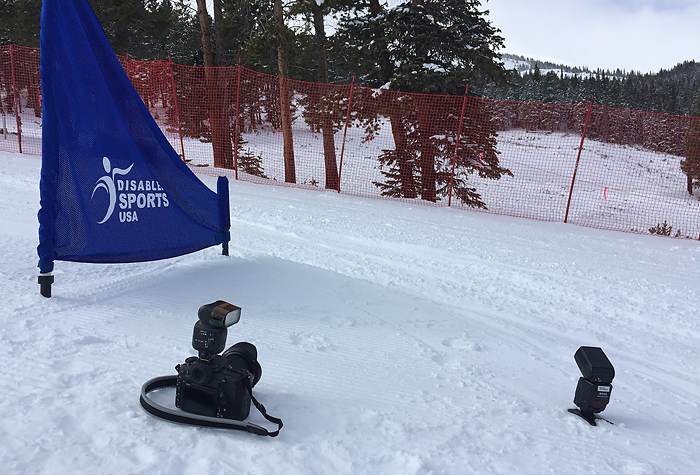
This snap from my iPhone shows where I was lying, and how I used the SB-500 on the camera to trigger the SB-800 to the right. Note I also had the head of the SB-800 angled up, and had manually zoomed the output to 50mm to push most of the light into the snowboarder’s torso. Photo copyright Reed Hoffmann.
Sled hockey is another sport that’s taught and played during the week, and takes place at an indoor rink. My first challenge there was access. Obviously, you can’t be on the ice while they’re playing. But what about before? I took advantage of warm-ups to be out on the ice, which let me make different photos than I could when they were playing.
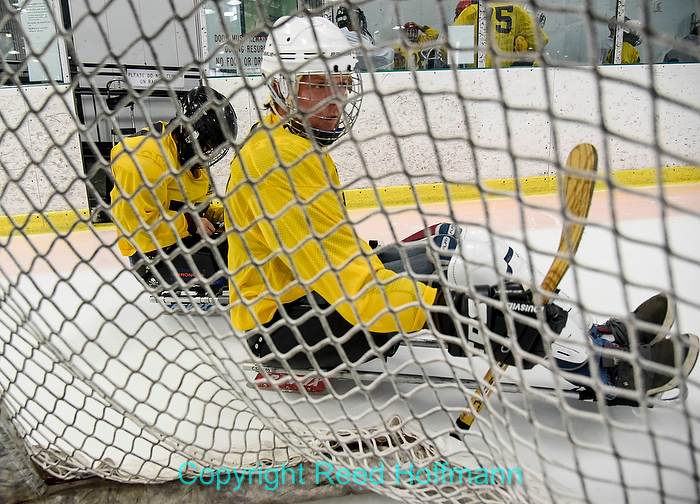
Getting out on the ice before they started playing let me make some different pictures, like this one shooting through the net. Nikon D750, Aperture Priority, ISO 3200, 1/320 at f/4.5, EV +0.3, 10-24mm f/4 Nikkor lens at 24mm. Photo copyright Reed Hoffmann.
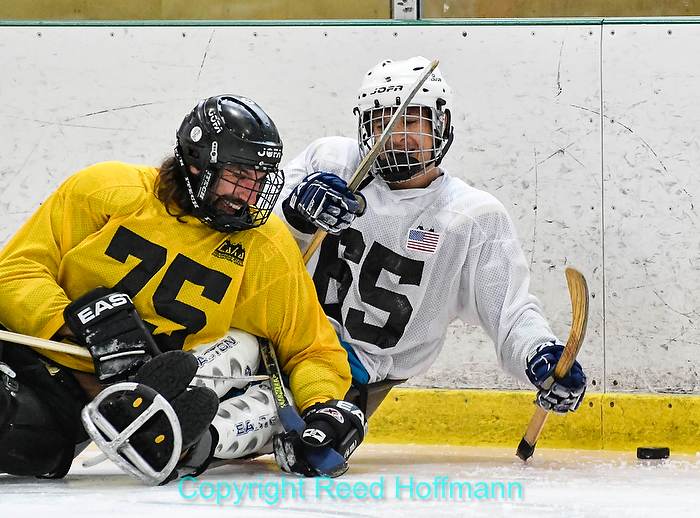
With the relatively slow 70-300mm lens, it was particularly helpful to have a camera that did a nice job at high ISOs. Otherwise my shutter speed would have been too slow to stop action like this. Nikon D500, Aperture Priority, ISO 8000, 1/500 at f/5.3, EV +0.7, 70-300mm f/4.5-5.6 Nikkor lens at 230mm. Photo copyright Reed Hoffmann.
The second challenge was light, or actually the lack of it. For ski racing on the mountain, my telephoto is the Nikkor 70-300mm f/4.5-5.6. Its compact size and excellent performance means I don’t have to ski with a larger, heavier lens. But it’s not a “fast” lens, which makes it harder to use indoors. Fortunately, I also had the Nikon D500. It does an excellent job at high ISO’s, so I was able to use that lens to zoom in on action and still have a high enough shutter speed to stop that action.
The last “think different” thing I did at the rink was create a time lapse. The Nikon cameras I use have that capability built in, so I put the D750 at the top of the stands on a tripod and set it for one-second intervals. That gave DSUSA something a little different to post on social media that day.
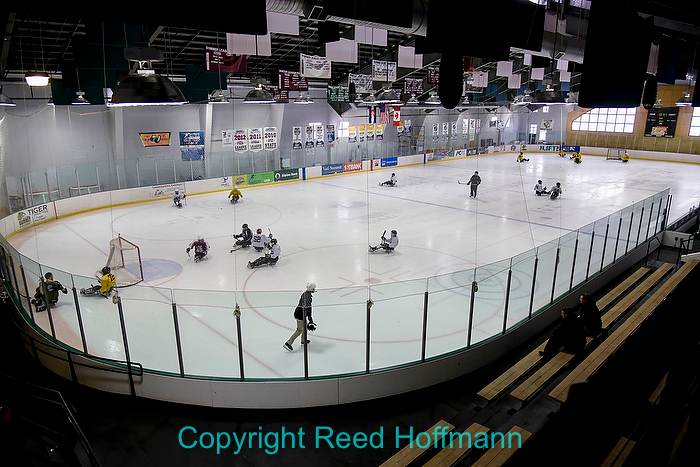
This is the angle and framing I used for the time lapse of the action. Nikon D750, Manual mode, ISO 2000, 1/250 at f/4.5, EV +1.3, 24-120mm f/4 Nikkor lens at 24mm. Photo copyright Reed Hoffmann.
The D500 also allowed me to work differently on the mountain while shooting skiing. As I mentioned before, since I’m skiing with a pack (and don’t want to kill myself), I use smaller and lighter gear than I otherwise might. That’s why I’ve used DX cameras in the past, both for their size and their crop factor (gives more “reach” out of my telephotos). The D500 is also a DX body, meaning smaller (compared to the D4 or D5 series), but with added power over the other DX cameras. That power was most noticeable in autofocus speed and frame rate. The AF system in the D500 is the fastest, most powerful now made by Nikon (same as in the D5). That meant I had even more in-focus shots of skiers speeding towards me. Plus, it’s even more accurate, meaning it was able to track accurately even with other things in the way (like race gates). And being able to shoot at 10 frames per second gave me more choices of “best” frames at critical moments.

With the powerful autofocus system of the D500, I was able to track and keep the skiers in focus even as they blasted through gates on the course. Nikon D500, Aperture Priority, ISO 400, 1/3200 at f/7.1, EV +0.7, Nikkor 70-300mm f/4.5-5.6 lens at 250m.
Photo copyright Reed Hoffmann.
I like telling people that “different” is one of the most important words in photography. Whenever possible, consider how you might shoot your photos differently than what you, or others, have shot in the past. Sometimes that’s a different angle or technique, and sometimes it’s simply taking advantage of new features or technology. Whatever you do, though, it’s likely to result in a more interesting picture. And that’s how you become a better photographer.
(If you like this story, please share it with your friends, and let them know about the links on photography I post on my business Facebook page. I’m also on Instagram @reedhoffmann)

